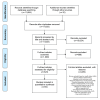Global trends in prevalence of maternal overweight and obesity: A systematic review and meta-analysis of routinely collected data retrospective cohorts
- PMID: 40313349
- PMCID: PMC12045326
- DOI: 10.23889/ijpds.v9i2.2401
Global trends in prevalence of maternal overweight and obesity: A systematic review and meta-analysis of routinely collected data retrospective cohorts
Abstract
Pregnant women with obesity are at greater risk of complications during pregnancy, peripartum and post-partum, compared to women with healthy BMI. Worldwide data demonstrating the changes in trends of maternal overweight and obesity prevalence informs service development to address maternal obesity, while directing resources to areas of greatest need. This systematic review and meta-analysis of population level data sought to evaluate global temporal changes in prevalence of maternal obesity and overweight/obesity, and compare trends between regions. Pooled prevalence of obesity and overweight/obesity was estimated using random effects meta-analysis. Temporal and geographical trends in prevalence of obesity and overweight/obesity were examined using linear regression. From 11,684 publications, 94 met inclusion criteria representing 121 study cohorts (Europe n = 71; North America n = 23; Australia/Oceania n = 10; Asia n = 5; South America n = 12), totalling 49,009,168 pregnancies. No studies from Africa met the inclusion criteria. Eighty studies (85.1%) were evaluated as having a low risk of bias and 14 studies (14.9%) moderate. In the most recent full decade (2010-2019), global prevalence of maternal obesity was estimated as 16.3% (95% confidence interval (CI): 15.1-17.5%), or approximately one in six pregnancies. Combined overweight/obesity in pregnancy had a pooled prevalence of 43.8% (95%CI: 42.2-45.4%), approaching half of all pregnancies. In each continent, an upward trend similar to the global trend was observed. North America demonstrated the highest prevalence (obesity: 18.7% (95%CI: 15.0-23.2%)); overweight/obesity: 47.0% (95%CI: 45.7-48.3%)) and Asia demonstrated the lowest prevalence (obesity: 10.8% (95%CI: 7.0-16.5%)); overweight/obesity: 28.5% (95%CI: 18.3-41.5%)). Both maternal obesity and combined overweight/obesity prevalence increased annually by 0.34% and 0.64% (p < 0.001), respectively. Our linear regression model estimates current global prevalence of maternal obesity as 20.9% (95%CI 18.6-23.1%) and projects that this will increase to 23.3% (95%CI 20.3-26.2%) by 2030. Globally, maternal obesity and overweight/obesity prevalence is high and increasing, but varies greatly between regions, being highest in North America and lower in Asia. Maternity services across the globe should be adequately resourced to cope with the complexity of needs of pregnant women living with obesity. Future public health interventions should focus on reversing the high prevalence of maternal obesity observed across the globe. The availability of population-level data and research varies between regions, with more data required to understand the needs of maternal populations in the continents of Africa and Asia. Globally, there is a need for improved harmonisation and publication of data for monitoring and improvement of maternal inequalities.
Keywords: BMI trends; Pre-pregnancy body mass index; early pregnancy body mass index; maternal obesity; maternal overweight; obesity trends; overweight trends.
Conflict of interest statement
Competing interests: The authors declare no competing interests.
Figures
References
-
- World Health Organization. Obesity. https://www.who.int/health-topics/obesity#tab=tab_1 (accessed 1 Oct 2021).
-
- World Health Organization Global Health Observatory. Prevalence of obesity among adults, BMI ≥30, crude - Estimates by WHO region. https://apps.who.int/gho/data/view.main.BMI30CREGv?lang=en (accessed 2023.August.25).
Publication types
MeSH terms
LinkOut - more resources
Full Text Sources
Medical
Miscellaneous




